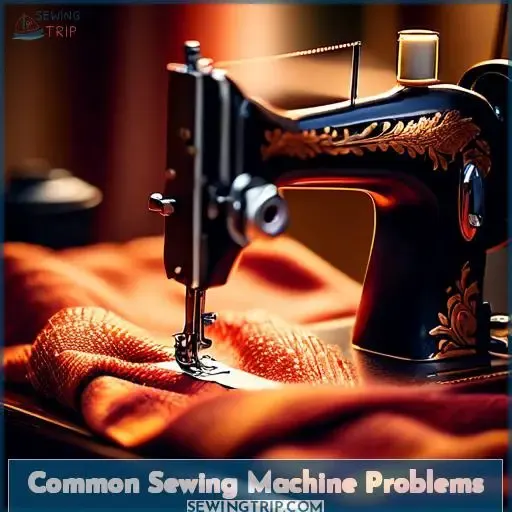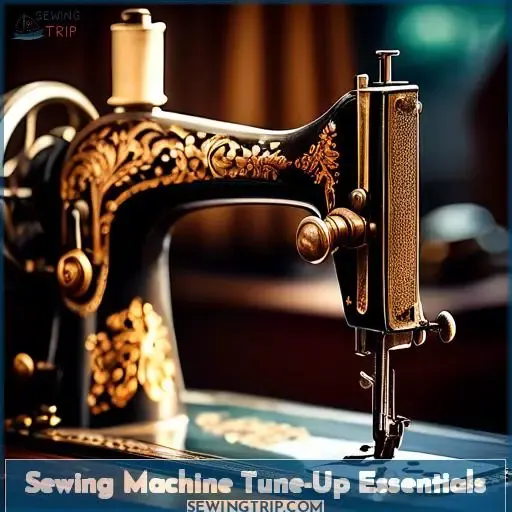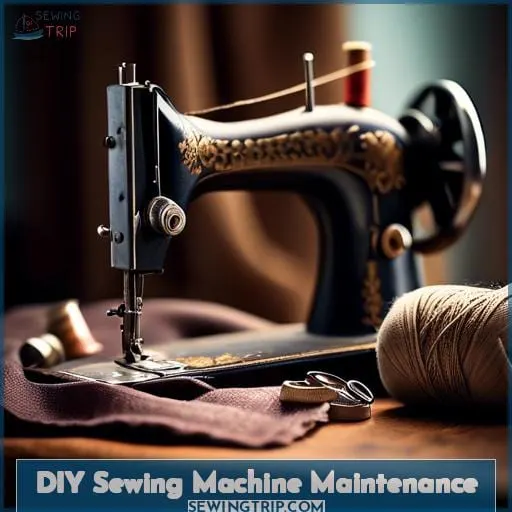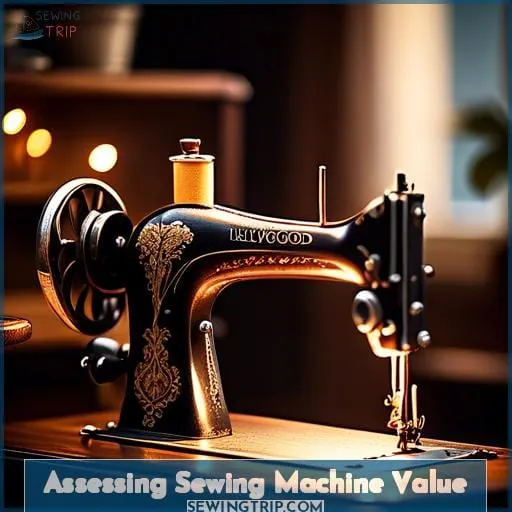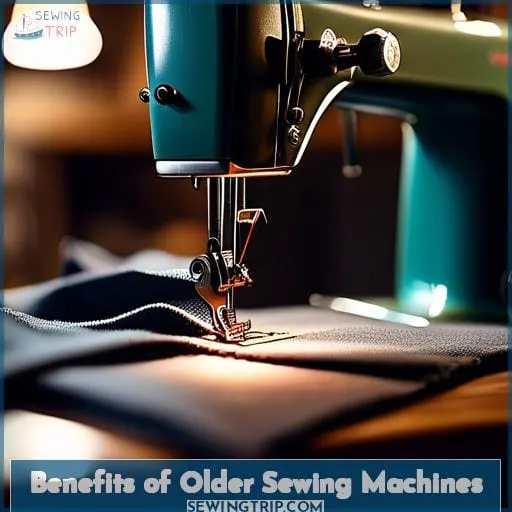This site is supported by our readers. We may earn a commission, at no cost to you, if you purchase through links.
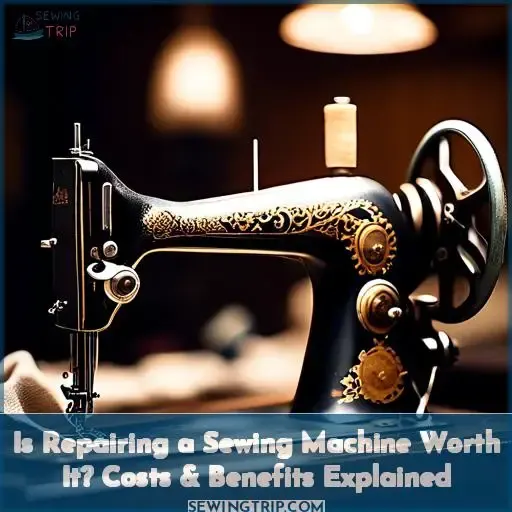 Imagine your sewing machine decides to throw a tantrum, stitching chaos instead of fabric.
Imagine your sewing machine decides to throw a tantrum, stitching chaos instead of fabric.
Before you consider hurling it out the window, let’s talk about whether repairing your sewing machine is worth the hassle and expense.
With a focus on practical experience and technical know-how, this guide dives into the costs and benefits of breathing new life into your trusty machine.
For those with a knack for innovation and mastery, understanding the ins and outs of sewing machine repair could save you more than just pennies.
Table Of Contents
Key Takeaways
- Repair costs should be weighed against the original purchase price of the sewing machine, considering the machine’s condition, performance, and the availability of parts and support.
- Older sewing machines, especially those with metal construction and gears, are often deemed more durable and worth repairing due to their quality of stitches and ease of repair.
- Regular maintenance, including cleaning and lubrication, is essential for both traditional and computerized sewing machines to ensure longevity and prevent common problems like thread bunching and needle breakage.
- The decision between repairing or replacing a sewing machine involves assessing usability, feature comparison, and sentimental value, alongside the financial aspect of investment in sewing machines.
Is It Worth Repairing a Sewing Machine
Yes, repairing a sewing machine is often worth it as it can save money in the long run and extend the machine’s lifespan. Costs vary, but regular maintenance and repairs can prevent the need for more expensive replacements.
Common Sewing Machine Problems
You’re likely familiar with the frustration of thread bunching or a snapped needle mid-project. These issues, along with fabric feed problems, thread breakage, and skipped stitches, are common hiccups that can disrupt your sewing flow.
Thread Bunching Under Fabric
Thread bunching under fabric? It’s a hiccup in your sewing journey. Dive into troubleshooting with a keen eye on tension causes, solutions, and DIY repair tricks.
Bent or Broken Needles
Bent needles? It’s a stitch in your side, right? Check needle type and length, avoid rough handling, and store properly to dodge this common sewing machine hiccup.
Fabric Not Feeding Properly
Just tackled bent needles? Now, if your fabric’s stuck, check the presser foot pressure, bobbin tension, and needle type—your manual’s your go-to guide.
Thread Breaking Frequently
If your thread’s snapping like a twig, check the tension, needle size, and thread quality.
Machine Skipping Stitches
After tackling thread breakage, let’s dive into skipped stitches. A mix of needle quality, thread tension, and fabric thickness often plays the culprit in this sewing snag.
Sewing Machine Tune-Up Essentials
You’ll need to consider a tune-up if your sewing machine’s performance is lagging. This essential maintenance includes cleaning, lubrication, and tension adjustments to keep your machine running smoothly.
Cleaning and Lubrication
To keep your sewing machine running smoothly, regular cleaning and proper lubrication are key. DIY maintenance like cleaning out dust and oiling critical parts can prevent issues. Remember, a well-maintained machine holds its value and avoids costly repairs or replacements.
Tension and Bobbin Checks
When tuning up your sewing machine, don’t overlook the bobbin case. A quick tension check can save you from a world of stitch strife. Is the bobbin thread misbehaving? A small tension adjustment could be the hero your fabric deserves.
Importance for Computerized Machines
Just as you wouldn’t run a car dry, your computerized machine craves regular lubrication. Opt for solvent refined oil with the right viscosity—non-staining, of course—to ensure your new sewing machine hums with reliability and longevity.
DIY Sewing Machine Maintenance
You’ll find that regular cleaning and lubrication of your sewing machine are key to its performance and longevity. Making tension adjustments as needed can also prevent common stitching issues and extend the life of your machine.
Regular Cleaning to Prevent Fluff
Keep your trusty stitcher humming; regular cleaning’s key. Dust bunnies aren’t just under the bed—they jam gears, too.
Lubrication for Smooth Operation
Lubricating your sewing machine’s mechanisms ensures needle penetration and thread tension match fabric compatibility. Choose the right oil viscosity for a smooth operation. It’s like greasing the wheels of your workhorse, making every stitch glide effortlessly.
Tension Adjustments
Tackling tension issues in your sewing machine? It’s like walking a tightrope. Too much upper tension, and your fabric puckers. Too little, and you’re in a tangle. Aim for that sweet spot where bobbin and upper tension harmonize, making every stitch a masterpiece.
Assessing Sewing Machine Value
You’ll want to weigh the repair costs against the original purchase price before deciding on fixing your sewing machine. Consider the machine’s current condition, availability of parts, and any sentimental value it may hold for you.
Repair Costs Vs. Purchase Price
Continuing from DIY upkeep, let’s dive into repair costs versus purchase price. Here’s what to weigh:
- Repair affordability against a new machine’s cost.
- Frequency of needed repairs.
- Purchase factors like warranty and brand reputation.
Machine Condition and Performance
After weighing repair costs, consider your machine’s condition. A well-kept vintage sewing machine often outperforms newer models, boasting superior durability and stitch quality that appeals to the intermediate sewer’s craft.
Parts Availability and Support
In the sewing machine saga, parts availability and support are your knights in shining armor. Hunting for Bernina parts? Availability and support for machines can turn a nightmare into a dream.
Sentimental Value Considerations
After delving into the nuts and bolts, let’s not forget the heartstrings. Your brother’s old machine isn’t just metal; it’s memories. Repairing it weaves emotional attachment into every stitch, making it priceless.
Benefits of Older Sewing Machines
You’ll appreciate the durability of older sewing machines’ metal construction. Their quality stitches and ease of repair make them a practical choice.
Durability of Metal Construction
Transitioning from assessing value, let’s dive into the durability of metal construction. Vintage machines boast an indestructible charm with their solid metal build, offering unmatched quality and strength.
Quality of Stitches
After marveling at the tank-like durability of older sewing machines, let’s dive into their stitch quality. You’ll find stitch consistency and accuracy unmatched, with a variety that modern machines often envy.
Ease of Repair
After marveling at the unmatched stitch quality, let’s dive into the ease of repair.
- Lower repair costs
- Simple tune-up benefits
- Legendary vintage durability
- Contrast with new machine features
- Can-do attitude for non-working finds
Choosing Between Repairing or Replacing
When you’re faced with the decision to repair or replace your sewing machine, it’s crucial to weigh the longevity and potential investment against the features and usability of new models. Consider the repair costs in relation to the original purchase price and the machine’s condition to determine if it’s a financially sound choice.
Repairing Vintage Vs. Buying New
After marveling at the resilience of older sewing machines, you’re now at a crossroads: repair a vintage gem or buy a new one? Weighing features, advantages, drawbacks, and price will guide you to uncover the true value of each path.
Usability and Feature Comparison
Transitioning from vintage charm to modern marvels, let’s dive into the usability and feature comparison.
- Programmable stitches for creativity that knows no bounds.
- An automatic threader saving precious time and sanity.
- Adjustable presser foot pressure for fabric finesse.
- Laser guide precision, because who doesn’t love a straight line?
Longevity and Investment in Sewing Machines
When pondering whether to repair or replace your sewing machine, consider it an investment. Vintage machines boast longevity and value, often outlasting newer models. Weighing the benefits, a stitch in time could mean saving nine—repair might just be worth it.
Frequently Asked Questions (FAQs)
How does humidity affect sewing machine performance?
Humidity’s a sneaky beast, wreaking havoc on your sewing machine’s performance. Too damp? Hello, rust and sticky parts. Too dry? Get ready for static shocks and brittle threads. It’s a balancing act to keep things humming.
Can sewing machine repairs be tax-deductible?
Ironically, sewing machine repairs can be a stitch in your tax deductions, if used for business. It’s like turning a snag into a feature, blending practicality with a dash of financial savvy.
Are there eco-friendly sewing machine lubricants?
Yes, there are eco-friendly sewing machine lubricants like DEWALT Biodegradable Chainsaw Oil and Liberty Oil’s Synthetic Lubricating Oil. They’re a slick choice for keeping your machine humming while being kind to the planet.
What is the impact of voltage fluctuations on sewing machines?
Voltage fluctuations can wreak havoc on your sewing machine, potentially frying circuits or causing erratic performance. It’s like riding a rollercoaster in the dark; thrilling, but you’d rather not, right? Keep it steady to avoid surprises.
How do sewing machine repairs affect warranties?
Unauthorized repairs can void your sewing machine’s warranty, so it’s wise to check the terms before tinkering.
Conclusion
Steering through the decision to repair your sewing machine is like threading a needle—precision is key.
If you’re weighing whether it’s worth repairing a sewing machine, consider the machine’s value, both monetary and sentimental, against the cost of repairs.
Older machines boast durability and stitch quality that often justify a tune-up.
Ultimately, your choice hinges on balancing practicality with your passion for sewing, ensuring your machine remains a reliable ally in your creative endeavors.

